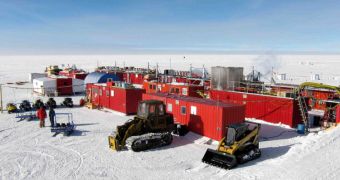Experts have been working on the IceCube project for years now, and they say that the experience has helped them reshape the way they deal with everyday problems. The nature of the project does not allow for anything else, they add.
IceCube is the name given to a project that calls for the construction of an advanced neutrino telescope under the South Pole, in Antarctica. Temperatures at that location can reach minus 100 degrees Fahrenheit, the investigators say.
Scientists say that working on this investigation is both challenging and exciting. Erik Verhagen and Camille Parisel, two IceCube engineers, say that their team members need to be very resourceful in order to withstand participation in the project.
Needless to say, the team is located very far away from any form of human civilization, which means that it has to be almost completely self-reliant no matter what.
“Whatever the problems are, you have to do it yourself, you can't call and say, 'Well, help me, I don't know how to do that.' Sometimes you don't even have the Internet,” Parisel explains.
“We work together to fix problems; we try to make it work and we help each other,” the expert adds. “Sometimes it happens that you are short of something, and you are creative, [so] you build it yourself. That's how you resolve problems,” Verhagen says.
Generally, the IceCub has as much as 250 employees at any given time. These scientists work on making one of the most intricate and unusual observatories in the world a reality.
The goal of the telescope is to study neutrinos, particles with tremendously low mass, and which do not readily interact with other particles. In order to study neutrinos, a vast sensors network was built.
The thousands of sensors making up the IceCube Neutrino Observatory are buried under neath the ice sheets, at depths reaching as much as one and a half miles.
Neutrinos “are very difficult to catch. They are just like light; there is basically no difference between neutrinos and light,” says Francis Halzen, a professor of physics at the University of Wisconsin.
“The only difference is that light doesn't go through a wall whereas neutrinos go through everything,” the investigator goes on to say.
“And so just accidentally, they run straight into the nucleus of an atom and then create lots of other particles, which we can see and it's only these accidental crashes of neutrinos that allow us to observe them. That's basically what IceCube is doing,” he adds.
IceCube's detectors are managed by investigators from 36 universities in seven different countries. Results obtained here could be used to gain more knowledge on the nature of dark matter.
Halzen and his group got funds to conduct the work from the US National Science Foundation (NSF).

 14 DAY TRIAL //
14 DAY TRIAL //